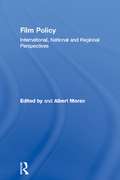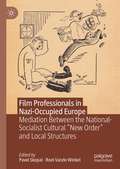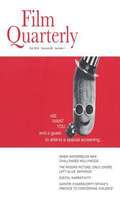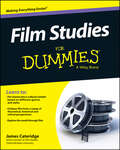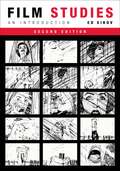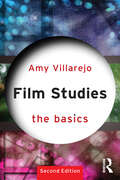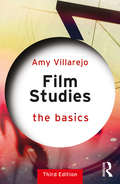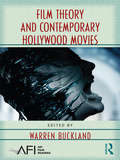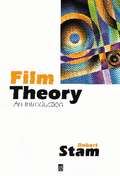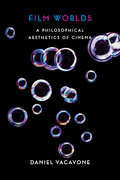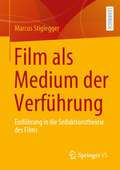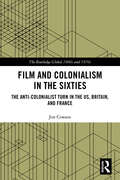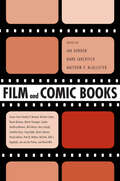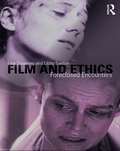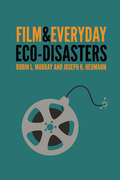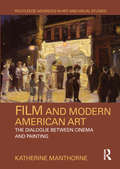- Table View
- List View
Film Policy: International, National and Regional Perspectives (Culture: Policy and Politics)
by Albert MoranFilm Policy is the first comprehensive overview of the workings of the international film industry. The authors examine film cultures and film policy across the world, explaining why Hollywood cinema dominates the global film market, and the effects of the rise of television and video on the international industry. In a series of case studies drawn from North America, Europe, Latin America, Asia and Australia, the authors explore the relationship between Hollywood cinema product and national film cultures, and trace the development of international and national film policies, looking at issues of financing, regulation, protectionism and censorship.
Film Professionals in Nazi-Occupied Europe: Mediation Between the National-Socialist Cultural “New Order” and Local Structures
by Roel Vande Winkel Pavel SkopalThis book analyses the film industries and cinema cultures of Nazi-occupied countries (1939-1945) from the point of view of individuals: local captains of industry, cinema managers, those working for film studios and officials authorized to navigate film policy. The book considers these people from a historical perspective, taking into account their career before the occupation and, where relevant, pays attention to their post-war lives. The perspectives of these historical agents” contributes to an understanding of how top-down orders and haphazard signals from the occupying administration were moulded, adjusted and distorted in the process of their translation and implementation. This edited collection offers a more dynamic and less deterministic approach to research on the international expansion of Third-Reich cinema in World War Two; an approach that strives to balance the role of individual agency with the structural determinants. The case studies presented in this book cover the territories of Belgium, Czechoslovakia, France, the Netherlands, Norway, Poland and the Soviet Union.
Film Quarterly Fall 2014
by B. Ruby RichFilm Quarterly has published substantial, peer-reviewed writing on cinema and media for nearly sixty years, earning a reputation as the most authoritative academic film journal in the United States, as well as an important English-language voice of cinema studies abroad.
Film Quarterly Spring 2014
by B. Ruby RichFilm Quarterly has published substantial, peer-reviewed writing on cinema and media for nearly sixty years, earning a reputation as the most authoritative academic film journal in the United States, as well as an important English-language voice of cinema studies abroad.
Film Quarterly Summer 2014
by B. Ruby RichFilm Quarterly has published substantial, peer-reviewed writing on cinema and media for nearly sixty years, earning a reputation as the most authoritative academic film journal in the United States, as well as an important English-language voice of cinema studies abroad.
Film Studies For Dummies
by James CateridgeMake sense of the world of cinema Want to pull back the curtain on film? This hands-on, friendlyguide unravels the complexities of film and helps you put cinemainto a cultural context. You'll get an easy-to-follow introductionto different film genres and styles, learn about the history ofcinema, get to know who makes up a filmmaking team, explore globalcinema from Hollywood to Bollywood and much more.Film Studies For Dummies will open your mind to how thefilm industry works and help you to discover the impact of film onpopular culture. You'll get easy-to-read information on analyzingand critiquing film from a range of theoretical, historical andcritical perspectives, and learn how people communicate ideas infilm. You'll also be able to shine a light on how stories aredeveloped in movies, understand how a storyline is related tobroader issues in society and become a well-versed and insightfulfilm student.Covers the narrative, artistic, cultural, economic andpolitical implications of cinemaProvides conceptual frameworks for understanding a film'srelationship to realityExplores how people tell stories and communicate ideas infilmHelps you excel as a student of filmWhether you're planning to study film, a humanities student witha forthcoming module on film or a film enthusiast wondering if thismight be the future for you, Film Studies For Dummies hasyou covered.
Film Studies, second edition: An Introduction (Film and Culture Series)
by Ed SikovFilm Studies is a concise and indispensable introduction to the formal study of cinema. Ed Sikov offers a step-by-step curriculum for the appreciation of all types of narrative cinema, detailing the essential elements of film form and systematically training the spectator to be an active reader and critic. He treats a number of fundamental factors in filmmaking, including editing, composition, lighting, the use of color and sound, and narrative. His description of mise-en-scene helps readers grasp the significance of montage, which in turn reveals the importance of a director’s use of camera movement.Film Studies is designed for courses on film history, film theory, and popular culture. Its straightforward explanations of core critical concepts, practical advice, and technical, visual, and aesthetic aspects anchor the reader’s understanding of the formal language and anatomy of film and the techniques of film analysis.The second edition of this best-selling textbook adds two new chapters: “Film and Ideology,” which covers how to read a film’s political and social content, and other key topics in film theory, and “Film Studies in the Age of Digital Cinema,” which explores the central problems of studying film when “film” itself is no longer the medium.
Film Studies: A Global Approach (The Basics)
by Amy VillarejoFilm Studies: The Basics is a compelling guide to the study of cinema in all its forms. This second edition has been thoroughly revised and updated to take account of recent scholarship, the latest developments in the industry and the explosive impact of new technologies. Core topics covered include: The history, technology and art of cinema Theories of stardom, genre and film-making The movie industry from Hollywood to Bollywood Who does what on a film set Complete with film stills, end-of-chapter summaries and a substantial glossary, Film Studies: The Basics is the ideal introduction to those new to the study of cinema.
Film Studies: An Introduction
by Warren BucklandAn unpretentious guide for all those who want to learn to analyse, understand and evaluate films. Film Studies: An Introduction provides an overview of the key areas in film studies, including aesthetics, narrative, genre, documentary films and the secrets of film reviewing. From Hitchcock and Tarantino to Spielberg and Bigelow, you will gain a critical understanding of legendary directors and the techniques and skills that are used to achieve cinematic effects. Whether you are a film studies student or just a film buff wanting to know more, this book will give you an invaluable insight into the exciting and incredibly fast-moving world of film. Understand Film Studies includes: Chapter 1: Film aesthetics: formalism and realism Chapter 2: Film structure: narrative and narration Chapter 3: Film authorship: the director as auteur Chapter 4: Film genres: defining the typical film Chapter 5: The non-fiction film: five types of documentary Chapter 6: The reception of film: the art and profession of film viewingfilm viewing Teach Yourself titles employ the 'Breakthrough method', which is designed specifically to overcome problems that students face. - Problem: "I find it difficult to remember what I've read."; Solution: this book includes end-of-chapter questions and summaries, and flashcards of key points available on-line and as apps - Problem: "Most books mention important other sources, but I can never find them in time."; Solution: this book includes key texts and case studies are summarised, complete with fully referenced quotes ready to use in your essay or exam. - Problem: "Lots of introductory books turn out to cover totally different topics than my course."; Solution: this book is written by a current university lecturer who understands what students are expected to know.
Film Studies: An Introduction: Teach Yourself
by Warren BucklandAn unpretentious guide for all those who want to learn to analyse, understand and evaluate films.Film Studies: An Introduction provides an overview of the key areas in film studies, including aesthetics, narrative, genre, documentary films and the secrets of film reviewing. From Hitchcock and Tarantino to Spielberg and Bigelow, you will gain a critical understanding of legendary directors and the techniques and skills that are used to achieve cinematic effects. Whether you are a film studies student or just a film buff wanting to know more, this book will give you an invaluable insight into the exciting and incredibly fast-moving world of film.Understand Film Studies includes:Chapter 1: Film aesthetics: formalism and realismChapter 2: Film structure: narrative and narrationChapter 3: Film authorship: the director as auteurChapter 4: Film genres: defining the typical filmChapter 5: The non-fiction film: five types of documentaryChapter 6: The reception of film: the art and profession of film viewing
Film Studies: The Basics (The Basics)
by Amy VillarejoA comprehensive overview of how to study film, this updated third edition provides concise and provocative summaries for approaching the language of film analysis, ways of thinking about film history, and approaches and methods for studying cinema, from national cinemas to genre to stardom and beyond. The new edition tracks the changes in film production and exhibition by situating the study of film within contemporary digital media cultures and structures, such as social media and streaming platforms. Without forsaking its emphasis on the study of film, the third edition updates its examples and provides fresh insight into today’s image culture. Film Studies: The Basics provides beginning students in film studies, as well as lifelong film buffs, with the tools to pursue film analysis, film history, and further inquiries into the medium.
Film Theory
by Felicity ColmanFilm Theory addresses the core concepts and arguments created or used by academics, critical film theorists, and filmmakers, including the work of Dudley Andrew, Raymond Bellour, Mary Ann Doane, Miriam Hansen, bell hooks, Siegfried Kracauer, Raul Ruiz, P. Adams Sitney, Bernard Stiegler, and Pier Paolo Pasolini. This volume takes the position that film theory is a form of writing that produces a unique cinematic grammar; and like all grammars, it forms part of the system of rules that govern a language, and is thus applicable to wider range of media forms. In their creation of authorial trends, identification of the technology of cinema as a creative force, and production of films as aesthetic markers, film theories contribute an epistemological resource that connects the technologies of filmmaking and film composition. This book explores these connections through film theorisations of processes of the diagrammatisation (the systems, methodologies, concepts, histories) of cinematic matters of the filmic world.
Film Theory
by Felicity ColmanFilm Theory addresses the core concepts and arguments created or used by academics, critical film theorists, and filmmakers, including the work of Dudley Andrew, Raymond Bellour, Mary Ann Doane, Miriam Hansen, bell hooks, Siegfried Kracauer, Raul Ruiz, P. Adams Sitney, Bernard Stiegler, and Pier Paolo Pasolini. This volume takes the position that film theory is a form of writing that produces a unique cinematic grammar; and like all grammars, it forms part of the system of rules that govern a language, and is thus applicable to wider range of media forms. In their creation of authorial trends, identification of the technology of cinema as a creative force, and production of films as aesthetic markers, film theories contribute an epistemological resource that connects the technologies of filmmaking and film composition. This book explores these connections through film theorisations of processes of the diagrammatisation (the systems, methodologies, concepts, histories) of cinematic matters of the filmic world.
Film Theory and Contemporary Hollywood Movies (AFI Film Readers)
by Warren BucklandFilm theory no longer gets top billing or plays a starring role in film studies today, as critics proclaim that theory is dead and we are living in a post-theory moment. While theory may be out of the limelight, it remains an essential key to understanding the full complexity of cinema, one that should not be so easily discounted or discarded. In this volume, contributors explore recent popular movies through the lens of film theory, beginning with industrial-economic analysis before moving into a predominately aesthetic and interpretive framework. The Hollywood films discussed cover a wide range from 300 to Fifty First Dates, from Brokeback Mountain to Lord of the Rings, from Spider-Man 3 to Fahrenheit 9/11, from Saw to Raiders of the Lost Ark, and much more. Individual essays consider such topics as the rules that govern new blockbuster franchises, the ‘posthumanist realism’ of digital cinema, video game adaptations, increasingly restricted stylistic norms, the spatial stories of social networks like YouTube, the mainstreaming of queer culture, and the cognitive paradox behind enjoyable viewing of traumatic events onscreen. With its cast of international film scholars, Film Theory and Contemporary Hollywood Movies demonstrates the remarkable contributions theory can offer to film studies and moviegoers alike.
Film Theory: An Introduction
by Robert StamThis book is a lively and provoking introduction to film theory. It is suitable for students from any discipline but is particularly aimed at students studying film and literature as it examines issues common to both subjects such as realism, illusionism, narration, point of view, style, semiotics, psychoanalysis and multiculturalism. It also includes coverage of theorists common to both, Barthes, Lacan and Bakhtin among others. Robert Stam, renowned for his clarity of writing, will also include studies of cinema specialists providing readers with a depth of reference not generally available outside the field of film studies itself. Other material covered includes film adaptations of works of literature and analogies between literary and film criticism.
Film Theory: Creating a Cinematic Grammar (Short Cuts)
by Felicity ColmanFilm Theory addresses the core concepts and arguments created or used by academics, critical film theorists, and filmmakers, including the work of Dudley Andrew, Raymond Bellour, Mary Ann Doane, Miriam Hansen, bell hooks, Siegfried Kracauer, Raul Ruiz, P. Adams Sitney, Bernard Stiegler, and Pier Paolo Pasolini. This volume takes the position that film theory is a form of writing that produces a unique cinematic grammar; and like all grammars, it forms part of the system of rules that govern a language, and is thus applicable to wider range of media forms. In their creation of authorial trends, identification of the technology of cinema as a creative force, and production of films as aesthetic markers, film theories contribute an epistemological resource that connects the technologies of filmmaking and film composition. This book explores these connections through film theorisations of processes of the diagrammatisation (the systems, methodologies, concepts, histories) of cinematic matters of the filmic world.
Film Worlds
by Daniel YacavoneDaniel Yacavone is Lecturer in Film Studies at the University of Edinburgh, where he has been acting director of Film Studies within the School of Literatures, Languages, and Cultures and has held a British Academy Postdoctoral Fellowship.
Film Worlds: A Philosophical Aesthetics of Cinema
by Daniel YacavoneFilm Worlds unpacks the significance of the "worlds" that narrative films create, offering an innovative perspective on cinema as art. Drawing on aesthetics and the philosophy of art in both the continental and analytic traditions, as well as classical and contemporary film theory, it weaves together multiple strands of thought and analysis to provide new understandings of filmic representation, fictionality, expression, self-reflexivity, style, and the full range of cinema's affective and symbolic dimensions.Always more than "fictional worlds" and "storyworlds" on account of cinema's perceptual, cognitive, and affective nature, film worlds are theorized as immersive and transformative artistic realities. As such, they are capable of fostering novel ways of seeing, feeling, and understanding experience. Engaging with the writings of Jean Mitry, Pier Paolo Pasolini, Christian Metz, David Bordwell, Gilles Deleuze, and Hans-Georg Gadamer, among other thinkers, Film Worlds extends Nelson Goodman's analytic account of symbolic and artistic "worldmaking" to cinema, expands on French philosopher Mikel Dufrenne's phenomenology of aesthetic experience in relation to films and their worlds, and addresses the hermeneutic dimensions of cinematic art. It emphasizes what both celluloid and digital filmmaking and viewing share with the creation and experience of all art, while at the same time recognizing what is unique to the moving image in aesthetic terms. The resulting framework reconciles central aspects of realist and formalist/neo-formalist positions in film theory while also moving beyond them and seeks to open new avenues of exploration in film studies and the philosophy of film.
Film als Medium der Verführung: Einführung in die Seduktionstheorie des Films
by Marcus StigleggerDie Seduktionstheorie definiert den Film im weiteren Sinne als ein Medium der Verführung, basierend auf dem französischen Begriff der séduction. Es handelt sich um einen von kontinentaler Philosophie und klassischer Filmtheorie geprägten theoretischen Ansatz, mit dem ein dreistufiges Analysemodell verknüpft ist. Das Buch führt in die theoretischen Grundlagen ein und stellt anhand unterschiedlicher klassischer und aktueller Beispiele aus der Filmgeschichte mögliche Analyseansätze vor.
Film and Colonialism in the Sixties: The Anti-Colonialist Turn in the US, Britain, and France (The Routledge Global 1960s and 1970s Series)
by Jon CowansRelations between Western nations and their colonial subjects changed dramatically in the second half of the twentieth century. As nearly all of the West’s colonies gained their independence by 1975, attitudes toward colonialism in the West also changed, and terms such as empire and colonialism, once used with pride, became strongly negative. While colonialism has become discredited, precisely when or how that happened remains unclear. This book explores changing Western attitudes toward colonialism and decolonization by analyzing American, British, and French popular cinema and its reception from 1960 to 1973.
Film and Comic Books
by Ian Gordon, Mark Jancovich and Matthew P. McAllisterContributions by Timothy P. Barnard, Michael Cohen, Rayna Denison, Martin Flanagan, Sophie Geoffroy-Menoux, Mel Gibson, Kerry Gough, Jonathan Gray, Craig Hight, Derek Johnson, Pascal Lefevre, Paul M. Malone, Neil Rae, Aldo J. Regalado, Jan van der Putten, and David Wilt In Film and Comic Books contributors analyze the problems of adapting one medium to another; the translation of comics aesthetics into film; audience expectations, reception, and reaction to comic book-based films; and the adaptation of films into comics. A wide range of comic/film adaptations are explored, including superheroes (Spider-Man), comic strips (Dick Tracy), realist and autobiographical comics (American Splendor; Ghost World), and photo-montage comics (Mexico's El Santo). Essayists discuss films beginning with the 1978 Superman. That success led filmmakers to adapt a multitude of comic books for the screen including Marvel's Uncanny X-Men, the Amazing Spider-Man, Blade, and the Incredible Hulk as well as alternative graphic novels such as From Hell, V for Vendetta, and Road to Perdition. Essayists also discuss recent works from Mexico, France, Germany, and Malaysia.
Film and Ethics: Foreclosed Encounters
by Lisa Downing Libby SaxtonFilm & Ethics considers a range of films and texts of film criticism alongside disparate philosophical discourses of ethics by Levinas, Derrida, Foucault, Lacanian psychoanalysts and postmodern theorists.
Film and Everyday Eco-disasters
by Robin L. Murray Joseph K. HeumannEco-disasters such as coal-mining accidents, oil spills, and food-borne diseases appear regularly in the news, making them seem nearly commonplace. These ecological crises highlight the continual tensions between human needs and the environmental impact these needs produce. Contemporary documentaries and feature films explore environmental-human conflicts by depicting the consequences of our overconsumption and dependence on nonrenewable energy.Film and Everyday Eco-disasters examines changing perspectives toward everyday eco-disasters as reflected in the work of filmmakers from the silent era forward, with an emphasis on recent films such as Dead Ahead, an HBO dramatization of the Exxon Valdez disaster; Total Recall, a science fiction action film highlighting oxygen as a commodity; The Devil Wears Prada, a comment on the fashion industry; and Food, Inc., a documentary interrogation of the food industry. The authors evaluate not only the success of these films as rhetorical arguments but also their rhetorical strategies. This interdisciplinary approach to film studies fuses cultural, economic, and literary critiques in articulating an approach to ecology that points to sustainable development as an alternative to resource exploitations and their associated everyday eco-disasters.
Film and Modern American Art: The Dialogue between Cinema and Painting (Routledge Advances in Art and Visual Studies)
by Katherine ManthorneBetween the 1890s and the 1930s, movie going became an established feature of everyday life across America. Movies constituted an enormous visual data bank and changed the way artist and public alike interpreted images. This book explores modern painting as a response to, and an appropriation of, the aesthetic possibilities pried open by cinema from its invention until the outbreak of World War II, when both the art world and the film industry changed substantially. Artists were watching movies, filmmakers studied fine arts; the membrane between media was porous, allowing for fluid exchange. Each chapter focuses on a suite of films and paintings, broken down into facets and then reassembled to elucidate the distinctive art–film nexus at successive historic moments.
Film and Stereotype: A Challenge for Cinema and Theory (Film and Culture Series)
by Jörg SchweinitzSince the early days of film, critics and theorists have contested the value of formula, cliché, conventional imagery, and recurring narrative patterns of reduced complexity in cinema. Whether it's the high-noon showdown or the last-minute rescue, a lonely woman standing in the window or two lovers saying goodbye in the rain, many films rely on scenes of stereotype, and audiences have come to expect them. Outlining a comprehensive theory of film stereotype, a device as functionally important as it is problematic to a film's narrative, Jörg Schweinitz constructs a fascinating though overlooked critical history from the 1920s to today.Drawing on theories of stereotype in linguistics, literary analysis, art history, and psychology, Schweinitz identifies the major facets of film stereotype and articulates the positions of theorists in response to the challenges posed by stereotype. He reviews the writing of Susan Sontag, Roland Barthes, Theodor W. Adorno, Rudolf Arnheim, Robert Musil, Béla Balázs, Hugo Münsterberg, and Edgar Morin, and he revives the work of less-prominent writers, such as René Fülöp-Miller and Gilbert Cohen-Séat, tracing the evolution of the discourse into a postmodern celebration of the device. Through detailed readings of specific films, Schweinitz also maps the development of models for adapting and reflecting stereotype, from early irony (Alexander Granowski) and conscious rejection (Robert Rossellini) to critical deconstruction (Robert Altman in the 1970s) and celebratory transfiguration (Sergio Leone and the Coen brothers). Altogether a provocative spectacle, Schweinitz's history reveals the role of film stereotype in shaping processes of communication and recognition, as well as its function in growing media competence in audiences beyond cinema.
